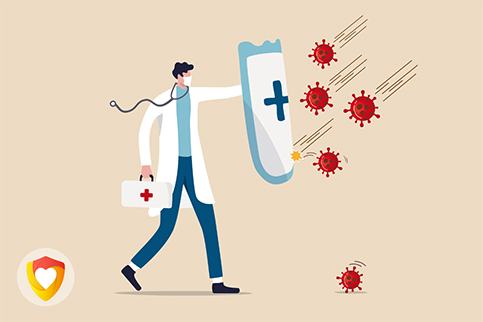COVID-19 is making a comeback, with many states reporting record case numbers. This raises the question: Are hospitals more prepared for this resurgence than they were at the start of the pandemic?
My answer is “mostly yes.” To illustrate, I invite you to relive my very first COVID-19 rule-out in late February.
At that time, there were several confirmed COVID-19 cases and at least one death in Seattle where I practice. However, this was the first patient to walk into our suburban emergency department (ED) and request testing.
This unmasked patient passed through the hospital lobby, waiting room, and triage areas before raising any red flags. When staff heard his high-risk history, he was escorted back outside while it took us some time to set up a negative pressure room and figure out what samples we needed to collect – our initial COVID-19 protocol was asking us to collect urine and fecal samples! I entered his room to perform the Emergency Medical Treatment and Labor Act-mandated screening exam wearing a mask but taking no other special precautions. As I left, I thought twice and left my stethoscope behind as a permanent donation to our new “COVID-19 room”.
So are we better prepared today? My answer is a resounding YES. However, as I’ll share in this post, there’s still work do.
Before I dive in, I think it’s important to acknowledge that COVID-19 is a localized experience. My version of “truth” here in Seattle will likely be different than that of New York City or small-town Iowa. However, I believe the following will hold true for most hospitals.
Causes to Celebrate
Some health systems and states have been accused of overreacting to the pandemic by stockpiling equipment, altering floorplans, installing negative pressure rooms, investing in telehealth infrastructure, canceling elective procedures, and creating new surge hospitals — all at great expense.
The truth is that these measures no doubt saved lives. What’s more, they helped clarify what works and what doesn’t when it comes to managing COVID-19.
What are we doing differently today? First, many hospitals have altered their workflows for maximum infection control. In contrast to my early experience above, today’s patients are screened for COVID-19 symptoms before they even enter the hospital doors. High-risk patients follow different pathways through the ED, often to negative pressure rooms. At some hospitals, they’re directed to cars, tents, or onsite COVID-19 clinics for care.
Telehealth has also improved patient and provider safety. Most hospitals have invested in telehealth platforms and dedicated mobile devices. What’s more, regulations have relaxed, reducing the need for face-to-face contact and allowing some visits to be completed 100% virtually.
In addition, thanks to near-universal pandemic preparation by hospitals, we’re now able to distribute COVID-19 patients among locations with open intensive care unit (ICU) beds. This reduces the risk that any single ICU will become overwhelmed, forcing it to revert to crisis standards of care. We’re also less likely to end up in a scenario where non-specialists (think psychiatry residents or primary care physicians) must step in to manage critical patients.
And of course, we now have more tools to manage COVID-19 clinically. We have drugs like remdesivir and steroids which improve outcomes, though we still don’t have a truly impactful pharmaceutical treatment. Experience has also taught us to be less aggressive when it comes to intubation because many patients do just as well with less invasive interventions like high flow nasal cannulas.
What Still Needs to Happen
Earlier this week, a non-Vituity emergency physician friend of mine was called on to intubate a COVID-19 patient in the ED. As a safety measure, my friend’s hospital had procured a PAPR, a reusable powered respirator worn as a hood that is considered the gold standard for infection control.
On its face, this was a positive step, especially given current equipment shortages. However, at the moment my friend needed the PAPR, another emergency physician was wearing it. She therefore ended up performing the intubation wearing only an N-95 mask, which provides less protection during a high-risk procedure like intubation.
This disconnect between administrative belief (“we have PAPRs”) and front-line reality (“I can't get a PAPR when I need one”) is one of several challenges health systems must face to reach full pandemic preparedness. Healthcare administrators need to stay connected to clinical leaders — especially as our knowledge of COVID-19 continues to change by the day.
- One key step healthcare leaders can take is by holding providers accountable when it comes to infection control procedures. The truth is that doctors, advanced providers, and nurses experience “quarantine fatigue” just like the rest of us. Four months into the pandemic, some are letting down their guard.
According to the Centers for Disease Control, 505 healthcare workers in the U.S. have died from COVID-19 as of this writing. Because not all states report the deceased’s occupation, the true toll is likely much higher. And sadly, each of these deaths might have been prevented by using PPE, handwashing, or choosing telehealth over an in-person encounter. It's therefore not alarmist to send the message that infection control procedures are a life-or-death matter.
- Hospitals can also help providers navigate the ever-changing guidance around safety. For example, evidence is currently mounting for the likelihood of airborne transmission of COVID-19a. Hospitals should decide what they will do if recommendations change to require N-95 masks as a universal precaution, not just for aerosol generating procedures. But where will the masks be procured? Will they be sanitized and reused? What expectations will be communicated to clinicians?
- Finally, hospitals should update their capacity plans, including transfer protocols from one hospital to another. Early during the pandemic, patients in my Seattle hospital benefited from cancelations of elective procedures, which freed up resources for COVID-19 cases. However, with revenues plummeting, many hospitals will face financial pressures to remain open to elective patients for as long as possible. And as a practical matter, many surgeries that were canceled at the start of the pandemic shouldn’t be delayed indefinitely (for example, early-stage breast cancer removal). And as bed capacity becomes exhausted in one community, transfers with counties and states will become more important.
In Summary
The comforting news is that our healthcare systems will not be caught off-guard to the degree we were earlier in the pandemic. The past several months have been rich in learning opportunities, and our health systems and front-line clinicians are much better prepared as a result.
However, there’s still much work to do. Staying vigilant, strengthening systems, and improving communication between hospital administration and front-line providers will help us all to weather a resurgence — or second wave — of COVID-19.























